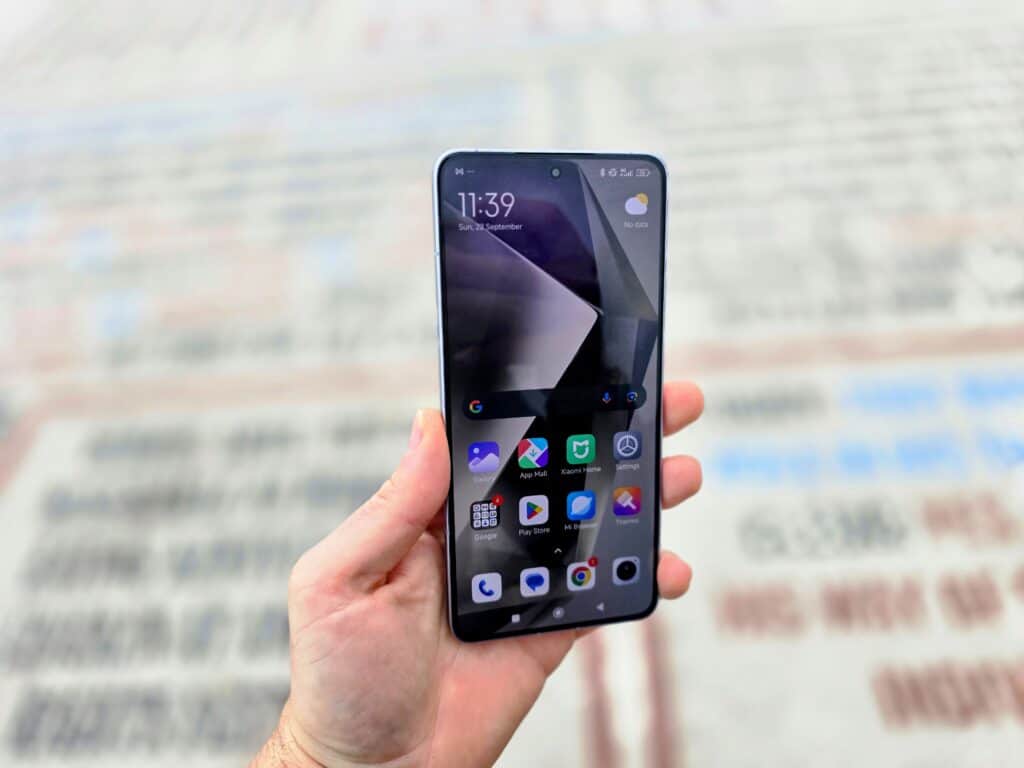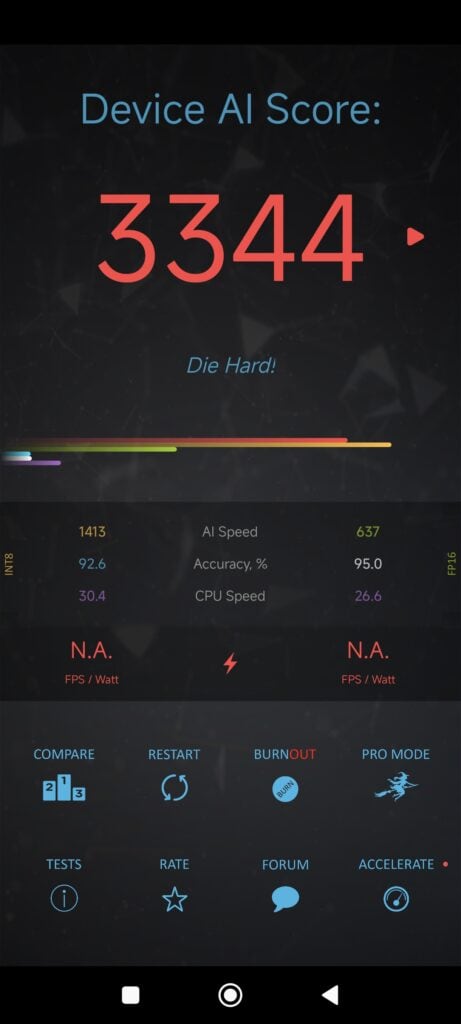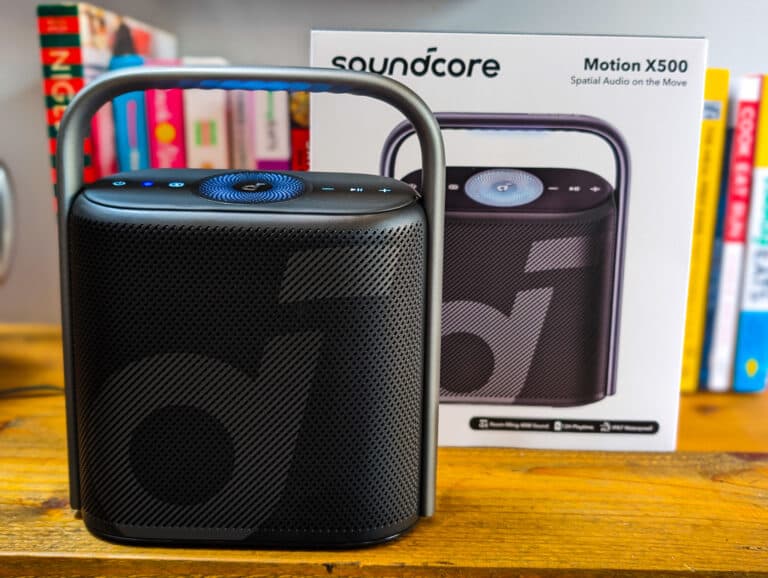Any links to online stores should be assumed to be affiliates. The company or PR agency provides all or most review samples. They have no control over my content, and I provide my honest opinion.
The Xiaomi 14T Pro is the latest affordable flagship phone from Xiaomi. Like the previous generation Xiaomi 13T Review, this phone slightly trims down the specs from the proper flagship Xiaomi 14 series to achieve a much more attractive price point.
This year, Xiaomi didn’t launch the 14 Pro in the UK, so the Xiaomi 14T Pro slots nicely into their current lineup nicely, giving you an option for a larger phone than the Xiaomi 14 with flagship features without breaking the bank for the top fo the range Xiaomi 14 Ultra.
Related Reviews
- Xiaomi 13T Review
- Xiaomi Watch S3 Smartwatch Review
- Xiaomi 14 Review
- Sony Xperia 5 V Review
- Xiaomi Watch S1 Pro
- Xiaomi Watch S1 Active Review
- Xiaomi 11T Revie
Xiaomi 14T Pro vs Xiaomi 14 Pro vs Xiaomi 13T Pro Specification

| Specification | Xiaomi 14T Pro | Xiaomi 14 Pro | Xiaomi 13T Pro |
| Display | OLED, 68B colours, 144Hz, Dolby Vision, HDR10+, 1600 nits (HBM), 4000 nits (peak) | LTPO AMOLED, 68B colours, 120Hz, Dolby Vision, HDR10+, 3000 nits (peak) | AMOLED, 68B colours, 144Hz, Dolby Vision, HDR10+, 1200 nits (HBM), 2600 nits (peak) |
| Display Size | 6.67 inches, 107.4 cm2 (~89.1% screen-to-body ratio) | 6.73 inches, 108.9 cm2 (~89.6% screen-to-body ratio) | 6.67 inches, 107.4 cm2 (~87.5% screen-to-body ratio) |
| Display Resolution | 1220 x 2712 pixels, 20:9 ratio (~446 ppi density) | 1440 x 3200 pixels, 20:9 ratio (~522 ppi density) | 1220 x 2712 pixels, 20:9 ratio (~446 ppi density) |
| Display Protection | Scratch/drop-resistant glass | Xiaomi Longjing Glass | Corning Gorilla Glass 5 |
| OS | Android 14, HyperOS | Android 14, HyperOS | Android 13, up to 4 major Android upgrades, HyperOS |
| Chipset | Mediatek Dimensity 9300+ (4 nm) Octa-core (1×3.25 GHz Cortex-X4 & 3×2.85 GHz Cortex-X4 & 4×2.0 GHz Cortex-A720) Immortalis-G720 MC12 | Qualcomm SM8650-AB Snapdragon 8 Gen 3 (4 nm) Octa-core (1×3.3 GHz Cortex-X4 & 3×3.2 GHz Cortex-A720 & 2×3.0 GHz Cortex-A720 & 2×2.3 GHz Cortex-A520) Adreno 750 | Mediatek Dimensity 9200+ (4 nm) Octa-core (1×3.35 GHz Cortex-X3 & 3×3.0 GHz Cortex-A715 & 4×2.0 GHz Cortex-A510) Immortalis-G715 MC11 |
| RAM | 12GB RAM / 16GB RAM | 12GB RAM / 16GB RAM | 12GB RAM / 16GB RAM |
| Storage | 256GB / 512GB / 1TB UFS 4.0 | 256GB / 512GB / 1TB UFS 4.0 | 256GB / 512GB / 1TB UFS 4.0 |
| Rear Camera | 50 MP, f/1.7, 23mm (wide), 1/1.31″, PDAF, OIS 50 MP, f/1.9, 50mm (telephoto), 1/2.88″, 0.61µm, PDAF, 2x optical zoom 12 MP, f/2.2, 15mm (ultrawide), 1/3.06″, 1.12µm | 50 MP, f/1.4-f/4.0, 23mm (wide), 1/1.31″, 1.2µm, dual pixel PDAF, OIS 50 MP, f/2.0, 75mm (telephoto), PDAF (10cm – ∞), OIS, 3.2x optical zoom 50 MP, f/2.2, 14mm, 115˚ (ultrawide), AF | 50 MP, f/1.9, 24mm (wide), 1/1.28″, 1.22µm, PDAF, OIS 50 MP, f/1.9, 50mm (telephoto), 1/2.88″, 0.61µm, PDAF, 2x optical zoom 12 MP, f/2.2, 15mm (ultrawide), 1/3.06″, 1.12µm |
| Features | Leica lens, LED flash, HDR, panorama | Laser AF, Leica lens, Dual-LED dual-tone flash, HDR, panorama | Leica lens, LED flash, HDR, panorama |
| Video | 8K@24/30fps, 4K@24/30/60fps, 1080p@30/60/120/240/960fps, gyro-EIS | 8K@24fps (HDR), 4K@24/30/60fps (HDR10+, 10-bit Dolby Vision HDR, 10-bit LOG), 1080p@30/60/120/240/960fps, 720p@1920fps, gyro-EIS | 8K@24fps, 4K@24/30/60fps, 4K/1080p@30fps HDR10+, 1080p@30/60/120/240fps; 10-bit LOG, gyro-EIS |
| Front Camera | 32 MP, (wide) | 32 MP, (wide) | 20 MP, f/2.2, (wide), 0.8µm |
| Video | 1080p@30fps | 4K@30/60fps, 1080p@30/60fps, gyro-EIS | 1080p@30fps, HDR10+ |
| Audio Quality | 24-bit/192kHz Hi-Res Wireless audio | 24-bit/192kHz Hi-Res audio | 24-bit/192kHz Hi-Res audio |
| WLAN | Wi-Fi 802.11 a/b/g/n/ac/6/7, dual-band, Wi-Fi Direct | Wi-Fi 802.11 a/b/g/n/ac/6e/7, dual-band, Wi-Fi Direct | Wi-Fi 802.11 a/b/g/n/ac/6e/7, tri-band, Wi-Fi Direct |
| Bluetooth | 5.4, A2DP, LE, LHDC | 5.4, A2DP, LE, aptX HD, aptX Adaptive | 5.4, A2DP, LE |
| Positioning | GPS (L1+L5), BDS (B1I+B1C+B2a+B2b), GALILEO (E1+E5a+E5b), QZSS (L1+L5), NavIC (L5), GLONASS | GPS (L1+L5), GLONASS (G1), BDS (B1I+B1c+B2a), GALILEO (E1+E5a), QZSS (L1+L5), NavIC (L5) | GPS (L1+L5), GLONASS (G1), GALILEO (E1+E5a), NavIC (L5), BDS |
| Infrared port | Yes | Yes | Yes |
| USB | USB Type-C 2.0, OTG | USB Type-C 3.2 Gen 2, OTG | USB Type-C 2.0, OTG |
| Sensors | Fingerprint (under display, optical), accelerometer, gyro, proximity, compass, colour spectrum | Fingerprint (under display, optical), accelerometer, proximity, gyro, compass, barometer, colour spectrum | Fingerprint (under display, optical), accelerometer, gyro, proximity, compass, colour spectrum |
| Circle to Search | Two-way satellite communication (Titanium version only) | ||
| Type | Li-Po 5000 mAh, non-removable | Li-Po 4880 mAh, non-removable | Li-Po 5000 mAh, non-removable |
| Charging | 120W wired, PD3.0, QC4, 100% in 19 min (advertised) 50W Wireless Charging | 120W wired, PD3.0, QC4, 100% in 18 min (advertised) 50W wireless, 100% in 40 min (advertised) 10W reverse wireless | 120W wired, PD3.0, QC4, 100% in 19 min (advertised) |
| Colours | Titanium Black, Titanium Grey, Titanium Blue | Black, Silver, Titanium, Green | Alpine Blue, Meadow Green, Black |
| Build | IP68 dust/water resistant (up to 2m for 30 min) | Glass front, aluminum frame or titanium frame, glass back IP68 dust/water resistant (up to 1.5m for 30 min) | Glass front (Gorilla Glass 5), glass back or silicone polymer back, plastic frame IP68 dust/water resistant (up to 1.5m for 30 min) |
| SIM | Dual SIM (Nano-SIM, dual stand-by) | Nano-SIM and eSIM or Dual SIM (Nano-SIM, dual stand-by) | Nano-SIM and eSIM or Dual SIM (Nano-SIM, dual stand-by) |
| Dimensions | 160.4 x 75.1 x 8.4 mm (6.31 x 2.96 x 0.33 in) | 161.4 x 75.3 x 8.5 mm | 162.2 x 75.7 x 8.5 mm (6.39 x 2.98 x 0.33 in) |
| Weight | 209 g (7.37 oz) | 223 g or 230 g (7.87 oz) | 200 g or 206 g (7.05 oz) |
Xiaomi 14T Pro vs Xiaomi 14 vs Xiaomi 13T Pro Key Differences
The above specifications show that there is very little difference between last years 13T Pro and the new 14T Pro:
Display:
- Xiaomi 14T Pro & 13T Pro: OLED, 68B colours, 144Hz, Dolby Vision, HDR10+.
- Xiaomi 14 Pro: LTPO AMOLED, 68B colours, 120Hz, Dolby Vision, HDR10+ (higher display resolution and LTPO tech for variable refresh rate).
Display Size:
- Xiaomi 14T Pro & Xiaomi 13T Pro: 6.67 inches (~89.1% and ~87.5% screen-to-body ratio, respectively).
- Xiaomi 14 Pro: 6.73 inches (~89.6% screen-to-body ratio).
Display Resolution:
- Xiaomi 14T Pro & Xiaomi 13T Pro: 1220 x 2712 pixels, ~446 ppi.
- Xiaomi 14 Pro: 1440 x 3200 pixels, ~522 ppi (sharper display).
Display Protection:
- Xiaomi 14T Pro: Scratch/drop-resistant glass.
- Xiaomi 14 Pro: Xiaomi Longjing Glass (a proprietary glass).
- Xiaomi 13T Pro: Corning Gorilla Glass 5.
Operating System:
- Xiaomi 14T Pro & Xiaomi 14 Pro: Android 14, HyperOS.
- Xiaomi 13T Pro: Android 13 with up to 4 major Android upgrades, HyperOS.
Basically, the only difference between this and last year’s model is the new, more powerful MediaTek Dimensity 9300+ chipset, brighter display, a slightly different main camera sensor, a better selfie camera, WiFi 7 and any new features introduced with the OS (such as AI features).
Unboxing / Design

I was sent the model in Titanium Blue Grey, which also came with 11GB of RAM and a massive 1TB of storage.
I kind of love the design, it is simple, unstated and clean. The branding on the rear is barely visible and the overall build quality feels superb.
It is IP68 rated, so you shouldn’t have to worry about getting it wet, and it can handle an accidental drop in water without too much concern.
One minor gripe is that the USB port is USB Type-C 2.0. It won’t matter most of the time but it means file transfers are slow and also you can’t do thinks like display out via USB.
Within the box, you get a case, which is always useful for phones like this, as third-party options can be poor. You also get a charging cable, but sadly no charger. While I can understand why brands have been ditching chargers, many of these phones use a proprietary charging tech, so you can’t make the most of the ultra-fast charging until you pay for a branded charger.

Display

- Key Features
- 144Hz refresh rate
- 1.5K resolution (2712 x 1220)
- 4000 nits peak brightness
- 12-bit colour depth
- Support for HDR10+ and Dolby Vision
- The display is also TÜV Rheinland certified for eye comfort
The display on the Xiaomi 14T Pro is superb; while curved displays have been popular for a while, it seems brands are shifting back to flat displays as they are more usable. There is barely any bezel, so the phone still looks premium.
Then you have the 4000 nits peak brightness and 1600 nits in high brightness mode. This is a step up from the 1200/2600nits that the 13T Pro achieved, and I find the main benefit is visibility on bright days, though it is also important for HDR and Dolby Vision content.
For biometrics, you have the usual fingerprint scanner and face unlock. Both are fast and accurate. I rarely have to use my fingerprint as my face usually unlocks it faster.
Camera

- Key Features
- Leica Summilux Optical Lens: Triple lens system with five focal lengths for versatile photography.
- Light Fusion 900 Image Sensor: Exceptional low-light performance, reducing noise and improving dynamic range.
- Leica Main Camera (50MP): Large ƒ/1.6 aperture captures 32% more light than its predecessor.
- Leica Ultra-Wide & Telephoto Lenses: 12MP ultra-wide and 50MP telephoto cameras add more depth and flexibility.
- Advanced AI Imaging: Features like UltraHDR, Master Portrait, and Leica filters ensure each photo is stunning.
- Master Videography: Capture up to 8K at 30fps, with additional modes like MasterCinema and Director Mode for cinematic video creation.
The main camera on the 13T Pro was a 50MP Sony IMX 707 1/1.28″ sensor with 1.22µm individual pixels and Quad-Bayer RGB colour filter. The sensor sits behind a 24mm f/1.9 stabilized 7-element lens (OIS).
On the 14T Pro, it appears to have been updated with the same sensor found on the 14 and 14 Pro. This is a 50MP camera utilises a large 1/1.31″ sensor though it has a different f/1.6 aperture (vs the variable aperture, going from f/1.42 at its widest to f/4.0 when closed). The end result is a main camera that is capable of producing images with exceptional detail and low noise levels.
In good lighting conditions, photos exhibit accurate exposure, neutral white balance, and high detail preservation. The camera performs particularly well in landscape photography thanks to its ability to capture natural colours.
The Xiaomi 14T Pro’s telephoto camera boasts a 50MP sensor with a 50mm equivalent focal length, offering approximately 2x optical zoom compared to the main camera. With an f/1.9 aperture, this lens performs well in various lighting situations.
When used in good lighting conditions, the telephoto lens produces impressive results with excellent detail and colour consistency across the phone’s camera array. It’s particularly useful for portraits and capturing distant subjects with greater clarity than digital zoom would allow.
Just like the 13T Pro, the main drawback of the telephoto camera is the lack of optical image stabilisation.
The ultra-wide camera on the Xiaomi 14T Pro features a 12MP sensor with a 15mm equivalent focal length and an f/2.2 aperture. This lens allows you to capture a significantly wider field of view, making it ideal for landscape photography and group shots. The overall performance of this sensor is adequate and fine for things like social media, but it falls short of the performance you get from the 14 series with its larger sensor.
Performance and Benchmarks
- Key Features
- MediaTek Dimensity 9300+: This powerhouse processor delivers unmatched speed with its all-big-core CPU architecture, offering a 37% boost in multi-core performance.
- 144Hz AI Display: The 6.67-inch CrystalRes AMOLED display supports a 144Hz refresh rate and offers a 1.5K resolution for ultra-smooth visuals.
- Immersive Gaming: With the Immortalis-G720 GPU, the Xiaomi 14T Pro offers a 44% improvement in graphics performance, ideal for mobile gaming.
The overall performance of the phone is flawless, which is true for most phones with flagship chipsets. The MediaTek chipset trades blows with Qualcomm’s flagship Snapdragon chipset, but in real-life usage, I doubt anyone would notice any difference.
Benchmarks


Benchmarks are an unreliable way to determine a phone’s real performance, but they are the easiest way to demonstrate performance differences between generations and brands.
AI benchmarks are always interesting, as the two main benchmarks available produce wildly different results based on the chipset. If you only look at the AI benchmark, then the Pixel series looks terrible, but Geekbench AI shows it is performing significantly better.
- Antutu
- Xiaomi 14T Pro: 1,980,467
- Pixel 9 Pro XL: 1,284,698
- Pixel 8 Pro: 1,144,447
- Samsung Galaxy S24 Ultra: 1,945,797
- Honor Magic6 Pro: 1,874,472
- GeekBench 6
- Xiaomi 14T: 2182 / 7205
- Pixel 9 Pro XL: 1917 / 4600
- Pixel 8 Pro: 1763 / 4409
- Samsung Galaxy S24 Ultra: 2103 / 6640
- Honor Magic6 Pro: 2220 / 6897
- 3Dmark WildLife Stress Test
- Xiaomi 14T: Unable to run (Xiaomi blocks the 3Dmark servers prior to launch)
- Pixel 9 Pro XL: 9019 high, 7463 low, 82.8% stability
- Pixel 8 Pro: 8434 high, 5599 low, 66.4% stability
- Samsung Galaxy S24 Ultra: 17580 high, 9828 low, 55.9% stability
- Honor Magic6 Pro: 18,160 high, 11867 low, 65.4% stability,
- AI Benchmark
- Xiaomi 14T: 3344
- Pixel 9 Pro XL:
- Pixel 8 Pro: 718
- Samsung Galaxy S24 Ultra: 3196
- Geekbench AI
- Xiaomi 14T: 1651 / 1673 / 2299
- Pixel 9 Pro XL: 1934 / 2031 / 3138
- Samsung Galaxy S24 Ultra: 2542 / 2604 / 3663
Android 14 & HyperOS
Xiaomi doesn’t have the best reputation for its Android version. It often has a lot of bloatware, but this seems to be more of an issue with their more affordable brands like Redmi and Poco.
While the UI of this phone is not as clean as that of a Pixel, I’d say it is significantly worse than the majority of other brands, including Samsung, which heavily modify Android.
The Xiaomi 14 is supposed to get 4 years of major OS updates, plus an extra year on top of that for security patches. I would hope this is the same for the Xiaomi 14T series.
It is not as good as Google or Samsung, but the price point is lower, and I think 4 years is still decent.
AI Features
The 14T Pro integrates AI features across multiple modalities:
- Circle to Search with Google
- Google Gemini app integration
- AI Interpreter, Notes, and Recorder
- AI Image Editing and Portrait Design
- AI Film for enhanced video recording
I have to admit it is getting increasingly difficult to get excited about the thought of AI. Every brand uses it for marketing, and every phone seems to claim to do it.
For this phone, and many others claiming AI features, Circle to Search and Google Gemini are features from Android and Google rather than something unique to his phone.
The photo app has an AI plugin you can install but it doesn’t seem to provide any unique features that make it stand out as AI in comparison to all the other editing features that existing before AI become a buzzword.
Additionally, the marketing material states, “AI Interpreter, Notes, and Recorder”, but I can’t seem to see any features that are AI with these apps. Probably the only AI feature I have used on my phone is on the S24 Ultra with its built-in voice recorder transcribing and summarising function.
I am sure many of these features will be available or made better at launch, but for now, just like many other phones, the AI features are underwhelming at best.
Battery Life
- Key Features
- 5000mAh Battery: With an impressive 1600 battery life cycles, the 5000mAh battery offers all-day use.
- 120W HyperCharge & 50W Wireless Charging: Charge up to 100% in just 19 minutes with wired charging or 45 minutes wirelessly.
The Xiaomi 14T Pro comes with a 5000mAh battery, which seems to be the standard size for most phones nowadays. The MediaTek chipset is relatively energy efficient thanks to its 4nm TSMC fabrication process, and you should easily get a full day’s worth of use out of the phone.
As this phone doesn’t come with a charger, I wasn’t able to take advantage of the incredible 120W charge speeds.
Thankfully, using a good power delivery charger still allows you to charge the phone very fast. Using my Anker 737 Power Bank, I saw the phone hit around 70W charge speeds, which is fast enough for my needs.
Price and Alternative Options
Xiaomi has reviewed the pricing as:
- Xiaomi 14T Pro comes with three storage variants, starting from EUR 799 (£666)
- Xiaomi 14T comes with two storage variants, starting from EUR 649 (£541)
- Xiaomi MIX Flip comes with one storage variant, starting from EUR 1299 (£1083)
The Xiaomi 13T and 13T Pro launched at £549 and £649, respectively, and I hope that the official UK price will be about the same.
Xiaomi always has early bird discounts, and this is the best time to grab a phone if you want one, as you can normally get a decent discount and some expensive free accessories.
The flagship Xiaomi 14 Pro was launched in the UK, so the best option from Xiaomi that sits above that is the Xiaomi 14 Ultra, which will set you back £1,299.
Assuming a £650 price point then, alternative options include:
- Honor 200 Pro for £549: I’d say this is the best alternative. You have the Snapdragon 8s Gen 3, which is not quite as good as the MediaTek but not far off. Then, a similar camera specification, it has 100W wired charging but also 66W wireless and a larger battery. The display then has a lower refresh rate but higher peak brightness.
- OnePlus 12 costs £150 more, but the chipset is slightly better; you have a superior camera spec, faster USB Type-C 3.2 and a larger battery. It has slightly slower wired charging, but you have 50W wireless. The display is higher resolution and brightness, it also uses LPTO but has a slightly lower maximum refresh rate of 120Hz.
- Pixel 9 at £799 – This has a better camera, a cleaner OS and better support but falls short everywhere else, including the price.
- Pixel 8 at £599 – Good phone with a nice clean OS but doesn’t compete with hardware
Overall
The Xiaomi 14T Pro is a superb phone, and it occupies what I think is the sweet spot for phones at the moment, with only a small number of competing choices.
I feel that £550-800 is a sweet spot because you have phones like this, the Honor 200 Pro or the flagship OnePlus 12. All three of these phones offer essentially a flagship experience with high-performance chipsets, superb cameras, great displays and ultra-fast charging.
As much as I love my Samsung Galaxy S24 Ultra or the Pixel 9 Pro XL, I feel like they don’t provide £300-500 difference in performance.
As always with Xiaomi, I’d say the main issues are the bloatware and overall UI. Perhaps I am just getting used to HyperOS, but the bloatware doesn’t seem as intrusive as some of the more affordable phones from Xiaomi’s sub-brands.
The other issue is how similar it is to the previous generation. All phones are guilty of this; the iPhone 16 is a particularly good example, and Samsung has barely made any changes to the Fold with each new generation. If you already own a 13T Pro, then there is absolutely no need to upgrade.
Overall, though, even with a few minor gripes, I love the Xiaomi 14T Pro. The hardware spec and overall performance are incredible for the price, proving there is no need to spend over £1k on a flagship phone.
Xiaomi 14T Pro Review
Summary
The Xiaomi 14T Pro is an impressive, affordable flagship that offers exceptional value for money. It delivers top-tier performance, an excellent camera system, and a stunning display, all at a price point that’s significantly lower than premium flagships. While it may not be a substantial upgrade from its predecessor, it’s an excellent choice for those seeking high-end features without breaking the bank.
Overall
90%-
Overall - 90%90%
Pros
- Powerful MediaTek Dimensity 9300+ chipset
- Excellent 144Hz OLED display with high brightness
- Versatile Leica-tuned camera system
- 120W fast charging capability
- IP68 water and dust resistance
- Competitive pricing
Cons
- Limited upgrades from the previous model
- HyperOS may have bloatware issues
- USB Type-C 2.0 port limits file transfer speeds and functionality
- AI features are somewhat underwhelming
I am James, a UK-based tech enthusiast and the Editor and Owner of Mighty Gadget, which I’ve proudly run since 2007. Passionate about all things technology, my expertise spans from computers and networking to mobile, wearables, and smart home devices.
As a fitness fanatic who loves running and cycling, I also have a keen interest in fitness-related technology, and I take every opportunity to cover this niche on my blog. My diverse interests allow me to bring a unique perspective to tech blogging, merging lifestyle, fitness, and the latest tech trends.
In my academic pursuits, I earned a BSc in Information Systems Design from UCLAN, before advancing my learning with a Master’s Degree in Computing. This advanced study also included Cisco CCNA accreditation, further demonstrating my commitment to understanding and staying ahead of the technology curve.
I’m proud to share that Vuelio has consistently ranked Mighty Gadget as one of the top technology blogs in the UK. With my dedication to technology and drive to share my insights, I aim to continue providing my readers with engaging and informative content.







